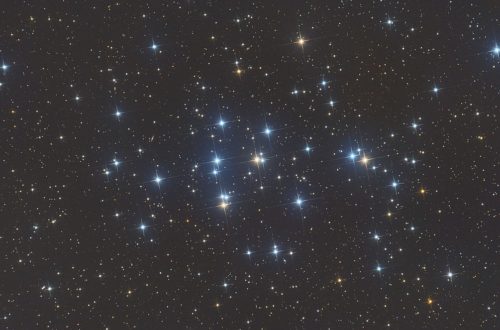Monthly Stargazing Calendar for September 2011
Looking for the September 2025 stargazing calendar?
This month you can witness a supernova with just binoculars or a small telescope. The supernova is called SN 2011fe and has been discovered by astronomers on August 24 within hours of its explosion. It is located within the Messier 101 galaxy (also known as M101) 23 million light-years away in the constellation of Ursa Major. The supernova will be getting brighter over the next few days until its peak on September 9th. This is the moment of a lifetime for stargazers, since most supernovae discovered are located hundreds of millions of light years away, which is far too distant to be spotted by anything short of a large observatory or a space telescope. So don’t miss it!

Image of the supernova taken by Thunderf00t (via Wikipedia).
On September 23 there will be an equinox. Known as the September equinox, it will occur at 09:05 UTC. The Sun will appear to shine directly on the equator and the day and night will be equal in length throughout the world. This date also marks the first day of fall (autumnal equinox) in the northern hemisphere and the first day of spring (vernal equinox) in the southern hemisphere.
Would you like to be notified of stargazing events?
On September 25 Uranus will be at Opposition. The giant planet will be at its closest approach to Earth and its face will be fully illuminated by the Sun making this the best time to view Uranus. Unfortunately, due to its extreme distance, you need a telescope to see the planet and, unless you have a really powerful telescope, it will only appear as a tiny blue-green dot.

Photo of Uranus taken by NASA’s Voyager 2 probe.
Moon phases
As you know, the Moon has a big impact on the visibility of celestial bodies in the night sky. So here are the Moon’s phases for this month:

Positions of the planets this month
Mercury: The closest planet to the Sun can be seen at dawn and dusk at the edge of the constellation of Leo. This planet, being the closest to the Sun, will appear to move quickly in the night sky and its position will change in the following weeks.
Venus: The sister planet can be seen also within the constellation of Leo, not far from the planet Mercury. Just like Mercury, the planet can only be seen at dawn and dusk.
Mars: The red planet can be seen in the constellation of Gemini. Three bright stars can also be seen nearby. They are: Alhena, Castor and Pollux.
Jupiter: The gas giant is visible between the constellations of Pisces, Cetus and Aries. Jupiter can easily be spotted with the naked eye, even in highly illuminated cities.
Saturn: The ringed giant can be seen with the naked eye in the middle of the Virgo constellation, not far from the bright stars Spica and Vindemiatrix.
Uranus: The gas giant can be seen between the constellations of Pisces and Cetus with the use of a telescope.
Neptune: The blue giant requires a telescope pointed in the constellation of Aquarius in order to be seen.
Astronomical events next month
- October 16 – Comet Elenin will make its closest approach to the Earth
- October 21, 22 – Orionid meteor shower peak
- October 29 – Jupiter at opposition
See also:
- Previous month’s calendar: Stargazing Calendar for August 2011
- Next month’s calendar: Stargazing Calendar for October 2011
Would you like to receive similar articles by email?






One Comment
Bridge
Stargazing was one of my hobby since every time there is a bad day, I climb up on the roof to think. The supernova from a distant looks like just a star and Uranus is so damn beautiful. Thank you for sharing.